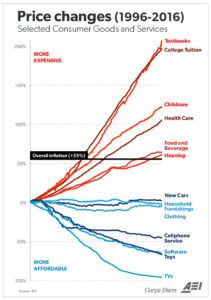
We know that hunger is present in every state and in every county in this land. It affects black America and white America, young and old, educated and not.
As such, we shouldn’t be surprised to learn that across the nation, the college student population is suffering from an ever increasing rate of food insecurity that affects their ability to learn and to ultimately remain in school. But we are.
As students return to school for the spring semester, we begin a three part series on campus hunger, looking at the depth of the problem and possible solutions.
The Dream
It’s the American dream for many children across the country. Receive your high school diploma, go onto college, graduate, get a good job and do one better than your parents did. But for many, the road to that dream is filled with challenges.
It is a challenge, however, that many are forced to take up regardless of their finances. The current workplace demands a degree. Employers expect job candidates to be degreed even though for many starting positions it may not be essential. For those who don’t go on to college, their resumes will likely not make it to a hiring manager’s desk. The prospective college student, weighing the cost of a 4 year education vs. the increased earnings over a lifetime is cause for serious consideration. Taking into account the education cost vs. the current starting salaries of many entry level positions becomes cause for trepidation.
The Cost of the Dream

Not that long ago, a student could pay a good deal of the costs of college by working part-time during the school year and full time during the summers. Today, that is unrealistic.
The cost of higher education has almost tripled over the past 20 Years. For the 1996-97 academic year, tuition and fees for a public four-year college averaged $2,966. For private schools the average cost was $12, 823. By the 2016-2017 school year the costs had risen to $9,650 for a public college and $33, 480 at a private school.
When the cost of books, housing, clothing and transportation are added in, what’s left over is sometimes not enough.
For low income students, the government funded Pell Grant enabled many students to attend college. In the 70’s, the grant was enough to cover practically all the costs of a community college and roughly 80% of a public four-year school. Today, the Pell Grant covers only about 60% of the cost of a community college and a third of four-year college costs.
“Fundamentally, our system doesn’t understand that a low-income student who gets financial aid to attend college does not receive an immediate battlefield promotion to the middle class. She still has the burdens and obligations of being in a low-income family. A system that doesn’t recognize this reality can set her, and itself, up for failure.”
Sara Goldrick-Rab from her book Paying the Price: College Costs, Financial Aid and the Betrayal of the American Dream
The Road to College
For many children of low income families, school was the one place where they could count on a meal. Free or reduced price meals, part of the free lunch program, generally followed students from lower to middle to high school. Many were even able to participate in summer meals programs during school vacations. For students of food insecure families, these were sometimes the only meals they could count on. Upon graduation, however, those meals stopped.
These same students, walking on campus for the first time as college freshmen, face an uncertain future. With just as little money, they now have much higher expenses, and decisions must be made between books, fees, housing, and lastly – food.
The Hunger on Campus
A recent study titled HUNGER on Campus compiled by the College and University Food Bank Alliance, the National Student Campaign Against Hunger and Homelessness, the Student Government Resource Center, and Student Public Interest Research Groups, reveals the state of today’s college students.
From the report:
“Consistent with prior studies, 48 percent of respondents reported food insecurity in the previous 30 days, including 22 percent with very low levels of food security that qualify them as hungry.”
“Drawing on a survey of almost 3,800 students at 34 community and 4-year colleges across 12 states – the broadest sample to date – the authors find that 22 percent of respondents have the very lowest levels of food insecurity, and 13 percent of students at community colleges are homeless. These figures are strikingly similar to our prior estimates, and help to confirm that far too many students today are struggling.”
The data, from a large sampling size and a broad geographic, suggests that hunger is much more prevalent among college students than previously thought and higher than in the U.S. population as a whole, 48% vs. 14% of US households who are food insecure according to the government.
Hunger impacts college students in the same ways that it does elementary, grade school and high school students; by effecting their mental health, their attendance, their concentration and ultimately their grades. While the tale of the starving student on the ramen diet have been told for years, this is profound hunger. 22% of the students surveyed did not know where their next meal was coming from multiple times during the course of a month.
The College and University Food Bank Alliance (CUBFA), is a recently formed organization that helps colleges set up and maintain on-campus food pantries. Now over 400 schools, from Ivy League to rural community colleges, are members. With hunger, there is no academic favoritism.
In our next part, we examine how colleges and communities are fighting back against hunger.
Want to make an impact?
Read the full HUNGER on Campus report to learn
more about the state of food insecurity on campus.
Find out if your alma mata has a food pantry,
if they do, donate food or funds.
If they don’t, find out how you can help start a pantry.
Share this article, or one of the many others written
about campus hunger on your social media pages.
Have a story you wish to share, comment on this article
or send us an email. We’d love to hear your experiences.
